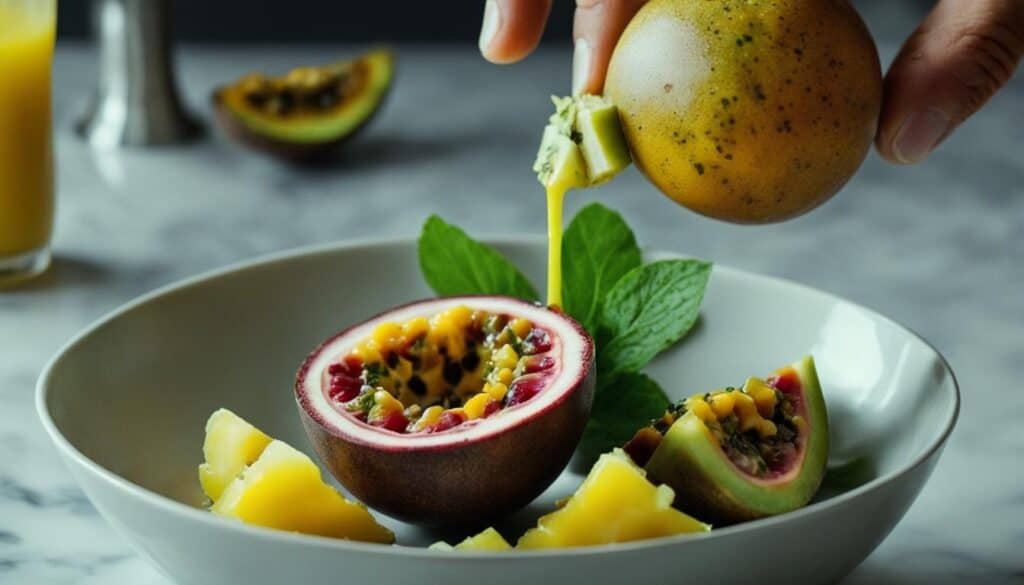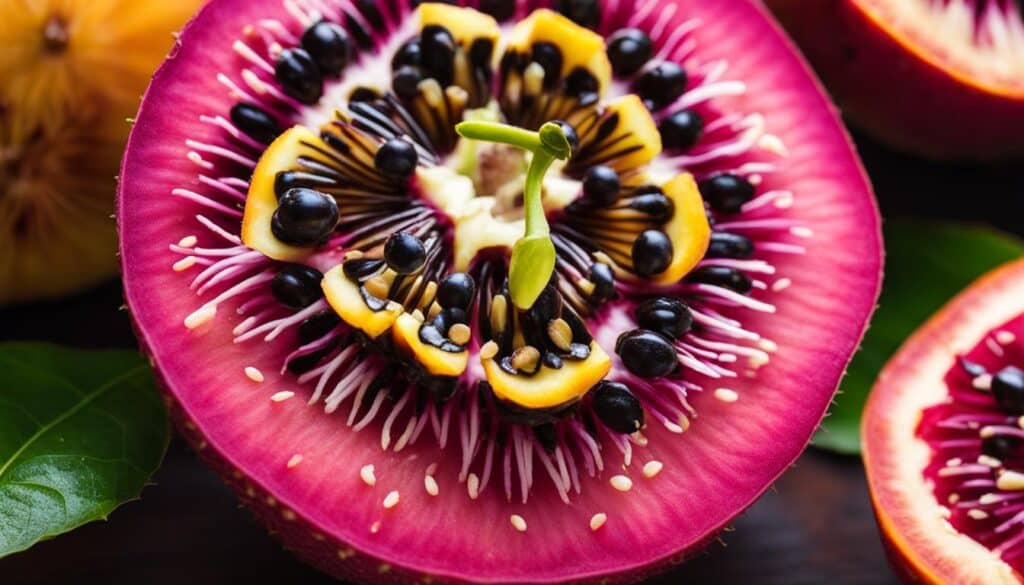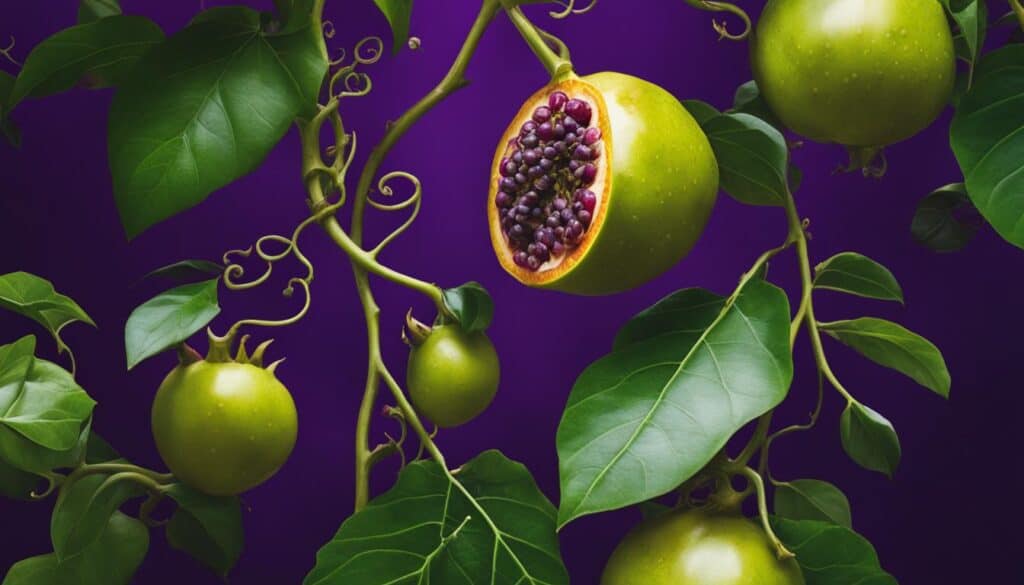Passion flower fruit, also known as passion fruit, is a tropical delight that has captured the attention of food enthusiasts around the world. Its vibrant color, unique taste, and potential health benefits make it a fascinating fruit to explore. In this article, I will delve into the question of whether passion flower fruit is edible and reveal the culinary wonders it holds.
Key Takeaways:
- Passion flower fruit, or passion fruit, is indeed edible and can be enjoyed by both humans and animals.
- The taste of passion fruit is a delightful combination of sweetness and tanginess, reminiscent of tropical flavors like pineapple, mango, and citrus.
- Passion fruit is packed with vitamins, antioxidants, and dietary fiber, making it a nutritious addition to your diet.
- Identifying the correct species of passion flower is essential to ensure the fruit is safe to eat.
- Passion fruit undergoes a ripening process, and when the skin becomes wrinkled and slightly soft, it is ready for consumption.
The Edibility of Passion Flower Fruit
Passion flower fruit, also known as passion fruit, is not only a beautiful tropical fruit but also a delicious and nutritious addition to your diet. As an avid fan of exotic fruits, I can’t help but rave about the eating experience and health benefits of passion fruit. Let me tell you all about it!
What does passion fruit taste like?
The taste of passion fruit is truly unique and delightful. It’s a perfect blend of sweet and tangy flavors, reminiscent of a tropical paradise. Imagine taking a bite and being greeted by the tropical essence of pineapple, mango, and citrus, all in one fruit. The flavor is intense and refreshing, leaving a pleasant tang on your palate. Trust me, it’s a taste sensation that you don’t want to miss!
Health benefits of passion flower fruit
Aside from its heavenly taste, passion fruit is packed with essential vitamins, antioxidants, and other nutrients that contribute to a healthy lifestyle. It’s rich in vitamin C, which supports a strong immune system and promotes collagen production for healthy skin. Passion fruit also provides a good dose of vitamin A, which is vital for maintaining healthy vision and skin. Moreover, the fruit is a great source of dietary fiber, aiding digestion and promoting a healthy gut.
In addition to vitamins, passion fruit contains a variety of antioxidants that help protect your body against harmful free radicals. These antioxidants contribute to overall well-being and may reduce the risk of chronic diseases such as heart disease and certain types of cancer.
Identifying Edible Passion Flower Species
When it comes to enjoying the deliciousness of passion flower fruit, it is crucial to correctly identify the edible species. The two most common types of passion flower plants that produce safe-to-eat fruits are Passiflora incarnata and Passiflora edulis.
Passiflora incarnata, also known as purple passionflower or maypop, bears exquisite purple flowers and yields delectable fruits. Its distinct flavor and nutritional benefits make it a popular choice among fruit enthusiasts. On the other hand, Passiflora edulis, commonly referred to as purple passion fruit, is renowned for its unique taste and vibrant appearance.
Before indulging in these delightful fruits, it’s essential to ensure that you have correctly identified the species. This step guarantees that you enjoy the fruit at the peak of its edibility and avoid any potential risks.
“The most common edible passion flower species include Passiflora incarnata and Passiflora edulis. Correctly identifying the species before consuming the fruit is key to ensuring its edibility.”
Now, let’s take a closer look at each species to understand their unique characteristics and how to differentiate them.
Passiflora incarnata: Purple Passionflower or Maypop
Also known as purple passionflower or maypop, Passiflora incarnata is a stunning vine that produces vibrant purple flowers and oval-shaped fruits. Here are some key features that can help you identify this species:
| Characteristic | Description |
|---|---|
| Flower Color | Purple |
| Fruit Shape | Oval |
| Fruit Color | Yellow when ripe |
| Fruit Size | Around 2-3 inches in diameter |
| Flavor | Sweet-tart with a hint of citrus |
| Growing Region | Mainly in North America |
Passiflora edulis: Purple Passion Fruit
Passiflora edulis, commonly referred to as purple passion fruit, is renowned for its delicious flavor and enticing aroma. Here are some distinctive characteristics of this species:
| Characteristic | Description |
|---|---|
| Flower Color | Purple |
| Fruit Shape | Round |
| Fruit Color | Purple or yellow when ripe |
| Fruit Size | Around the size of a tennis ball |
| Flavor | Sweet-tart with tropical notes |
| Growing Region | Tropical and subtropical regions worldwide |
By correctly identifying these two edible passion flower species, Passiflora incarnata and Passiflora edulis, you can confidently enjoy their delicious fruits. Remember, always verify the species before consuming passion flower fruit to ensure you have the best culinary experience possible.
The Ripening Process of Passion Fruit
Passion fruit goes through a natural ripening process, transforming from green to a vibrant yellow or purple hue. As the fruit matures, its skin develops wrinkles and becomes slightly soft, indicating that it is ripe and ready to eat.
When the passion fruit is ripe, it is safe and enjoyable to consume.
To savor the delectable flavors of passion fruit, follow these simple steps:
- Cut the fruit in half vertically, revealing the inner juicy pulp and seeds.
- Using a spoon, gently scoop out the pulp and seeds from each half.
The edible seeds of the passion fruit add a delightful crunch to the overall texture, complementing the juicy pulp perfectly.
Now that you know how to eat passion flower fruit and understand when it is safe to consume, indulge in the irresistible taste and refreshing goodness of this tropical delight.
Cooking with Passion Fruit
Passion fruit is a versatile ingredient that can elevate your culinary creations with its unique flavor and enticing aroma. Whether you’re planning a dessert, beverage, or savory dish, passion fruit can add a tangy and tropical twist that will leave your taste buds craving for more. Here are some delightful ways to incorporate this exotic fruit into your cooking:
Refreshing Drinks
Start by creating refreshing drinks that showcase the vibrant flavors of passion fruit. Whip up a batch of homemade passion fruit juice by blending the pulp with water and a touch of sweetener. For a more indulgent treat, mix passion fruit with other tropical fruits and create a refreshing cocktail to enjoy on warm summer days.
Delectable Desserts
Passion fruit works wonders in desserts, lending its distinctive taste and natural sweetness. Add a burst of flavor to your cheesecakes, tarts, and pavlovas by incorporating passion fruit into the filling or as a topping. The tangy notes of the fruit complement creamy textures and create a heavenly dessert experience.
Flavorful Sauces and Dressings
Take your sauces and dressings to the next level by adding the zing of passion fruit. Whip up a vibrant passion fruit sauce to accompany grilled seafood or drizzle it over salads for a refreshing twist. The tropical flavors of passion fruit can also enhance marinades and glazes, infusing your savory dishes with a burst of tanginess.
“Passion fruit adds a tangy and tropical twist to your culinary creations, making them truly unforgettable.”
Get creative with your passion fruit recipes and explore the endless possibilities this fruit has to offer. From sweet to savory, there’s no limit to what you can create when you cook with passion fruit. Let your culinary imagination run wild and discover new, mouthwatering combinations that will impress your family and friends.

So go ahead, embrace the exotic allure of passion fruit and infuse your dishes with its captivating flavors. Cooking with passion fruit will bring a delightful touch of the tropics to your table, leaving everyone wanting more.
Health Benefits of Passion Flower Fruit
In addition to its delicious taste, passion flower fruit offers several health benefits. Let’s explore the nutritional goodness that this tropical fruit brings:
- Vitamins: Passion flower fruit is a good source of essential vitamins, including vitamin C and vitamin A. These vitamins play a crucial role in supporting a healthy immune system and promoting overall well-being.
- Dietary Fiber: Passion fruit is also rich in dietary fiber, which aids digestion and helps maintain a healthy weight. A high-fiber diet can contribute to a reduced risk of heart disease and promote bowel regularity.
- Antioxidants: The fruit is packed with antioxidants that help protect the body against damage from free radicals. These antioxidants, such as vitamin C and flavonoids, may reduce the risk of chronic diseases, including heart disease and certain types of cancers.
- Minerals: Passion fruit contains several essential minerals that are important for maintaining optimal health. These minerals include potassium, which supports heart health, magnesium, which aids in muscle and nerve function, and iron, which is necessary for producing healthy red blood cells.
The health benefits of passion flower fruit make it a nutritious addition to your diet. Whether eaten fresh, added to smoothies, or used in various recipes, the fruit offers a burst of tropical flavor along with a wealth of essential nutrients.
So why not indulge in the goodness of passion flower fruit today and reap the rewards it has to offer?

Growing Passion Fruit in Your Garden
If you’re passionate about growing your own fruit, why not try your hand at cultivating passion fruit in your garden? With a few simple steps, you can enjoy the thrill of growing and harvesting your very own passion fruit.
Choosing the Right Location
Passion fruit vines thrive in warm and sunny locations, so choose a spot in your garden that receives full sunlight for at least six hours a day. The vines also need protection from strong winds, so consider planting them near a wall or fence for added support.
Preparing the Soil
The soil for your passion fruit plants should be well-draining and rich in organic matter. Before planting, loosen the soil with a garden fork or tiller and remove any weeds or debris. Mixing compost or aged manure into the soil will provide the plants with essential nutrients.
Planting Passion Fruit Vines
Passion fruit vines can be grown in containers or planted directly into the ground, depending on your garden space and preferences. If planting in containers, choose a pot that is at least 18 inches in diameter and fill it with well-draining potting mix. If planting in the ground, dig a hole twice the size of the vine’s root ball and gently place the plant into the hole, making sure the soil level matches the level of the vine’s root crown.
Caring for Your Passion Fruit Plants
Regular watering is essential for the growth and productivity of passion fruit plants. Keep the soil consistently moist, but not waterlogged, especially during dry spells. Mulching around the plants with organic mulch will help retain moisture in the soil and suppress weeds.
Passion fruit vines are fast growers and can become quite vigorous. To manage their growth, prune the vines regularly, especially during the dormant season. Pruning helps maintain the shape of the plant, improves air circulation, and encourages fruit production.
Harvesting Your Passion Fruit
Once your passion fruit vines start bearing fruit, it’s time to harvest and enjoy the delicious rewards. The fruits are ready to be picked when they turn color and feel slightly soft to the touch. Simply twist the fruit gently until it comes off the vine.
Remember, freshly harvested passion fruit can be stored at room temperature for a few days or stored in the refrigerator for up to two weeks. And don’t forget to save some seeds for planting new vines in the future!

With proper care and maintenance, you can turn your garden into a haven for growing passion fruit. Whether you’re a seasoned gardener or a beginner, growing passion fruit is a rewarding experience that allows you to enjoy the flavors of tropical paradise right in your own backyard.
Tips for Successful Passion Fruit Cultivation
To successfully cultivate passion fruit, providing the plants with the right conditions is crucial. Here are some essential tips for growing and caring for passion fruit:
1. Sunlight:
Passion fruit plants thrive in full sunlight. Make sure to choose a location in your garden that receives at least six hours of direct sunlight each day.
2. Watering:
Passion fruit plants require regular watering to keep the soil moist. However, it is important not to overwater, as this can lead to root rot. Water the plants deeply once or twice a week, ensuring the soil is well-drained.
3. Soil:
Passion fruit plants prefer well-draining soil with a pH between 6.5 and 7.5. Add organic matter such as compost or well-rotted manure to improve soil fertility and drainage.
4. Pruning:
Pruning is essential to manage the growth and spread of passion fruit vines. Regularly trim back any dead or damaged branches to promote healthy growth. Pruning also helps to increase the air circulation around the plants, reducing the risk of diseases.
5. Pest and Disease Control:
Protecting your passion fruit plants from pests and diseases is crucial for their health and productivity. Inspect the plants regularly and take prompt action if you notice any signs of pest infestations or fungal diseases. Use organic pest control methods or fungicides, if necessary, to manage these issues.
6. Temperature Protection:
Passion fruit plants are tropical and sensitive to frost. If you live in an area with cold winters, consider growing the plants in containers that can be moved indoors during the colder months. Alternatively, you can cover the plants with frost cloth or cultivate them in a greenhouse.
By following these tips, you can ensure the successful cultivation of passion fruit and enjoy a bountiful harvest of these delicious fruits.

Common Issues and Troubleshooting
Passion fruit vines, like any other plant, can encounter various issues and problems. It’s important to be aware of these common passion fruit vine problems and know how to troubleshoot them effectively. Some of the most common issues include:
- Pest infestations, such as aphids and whiteflies
- Fungal diseases, like powdery mildew
Regular inspections of your passion fruit vines are crucial in identifying and addressing these issues before they become severe. By taking proactive measures, you can prevent the problems from escalating and manage them effectively. Here are some troubleshooting tips:
- Use organic pest control methods, such as neem oil or insecticidal soap, to combat pest infestations.
- For fungal diseases like powdery mildew, apply appropriate fungicides as recommended by agricultural experts.
- Maintain proper care and maintenance practices, including regular watering, pruning, and fertilizing.
Here is an example of how to create a table to showcase common passion fruit vine problems and their corresponding troubleshooting methods:
| Problem | Troubleshooting |
|---|---|
| Pest infestations (aphids, whiteflies) | Use organic pest control methods, such as neem oil or insecticidal soap. |
| Fungal diseases (powdery mildew) | Apply appropriate fungicides as recommended by agricultural experts. |
By addressing these common passion fruit vine problems and implementing appropriate troubleshooting measures, you can ensure the health and productivity of your passion fruit plants. Proper care and maintenance, along with early intervention, will minimize the risk of problems and help you grow thriving passion fruit vines.
Conclusion
In conclusion, passion flower fruit, also known as passion fruit, is indeed edible and offers a delightful taste and nutritional benefits. With the right growing conditions and care, you can cultivate passion fruit plants in your own garden and enjoy the delicious fruits they produce. Whether eaten fresh or used in various recipes, passion fruit adds a tropical touch to your culinary adventures. So go ahead and explore the world of passion flower fruit for a truly tantalizing experience.
FAQ
Are passion flower fruit edible?
Yes, passion flower fruit is edible and can be consumed by both humans and animals.
What does passion fruit taste like?
Passion fruit has a sweet and tangy flavor, often described as a combination of tropical flavors like pineapple, mango, and citrus.
What are the health benefits of passion flower fruit?
Passion flower fruit is a good source of vitamins C and A, dietary fiber, and antioxidants. It also contains several minerals, including potassium, magnesium, and iron.
How do you eat passion flower fruit?
To eat passion flower fruit, you can cut it in half and scoop out the juicy pulp and seeds with a spoon. The seeds are edible and add a crunchy texture to the fruit.
Can passion fruit be used in cooking?
Yes, passion fruit can be used in a variety of culinary applications. It is a popular choice for desserts, beverages, sauces, and dressings.
How do you grow passion fruit in your garden?
Passion fruit vines require a warm and sunny location, well-draining soil, and regular watering. They can be grown in containers or planted directly in the ground.
What are some tips for successful passion fruit cultivation?
Provide your passion fruit plants with adequate sunlight, regular watering, and well-draining soil. Prune the vines to manage growth and spread. Protect the plants from extreme temperatures and pests.
What are some common issues and troubleshooting for passion fruit plants?
Common problems include pest infestations (e.g., aphids, whiteflies) and fungal diseases (e.g., powdery mildew). Regular inspections and proactive measures can help prevent and manage these issues. Proper care and maintenance are essential.





Leave a Reply